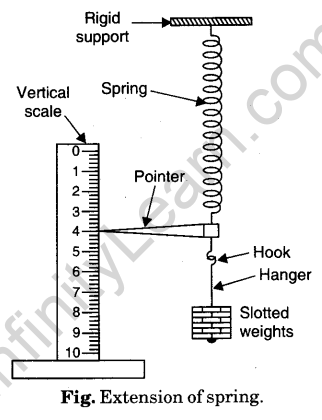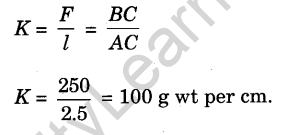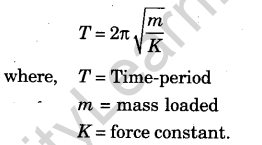Table of Contents
To Find the Force Constant of a Helical Spring by Plotting a Graph Between Load and Extension
Aim
To find the force constant of a helical spring by plotting a graph between load and extension.
Apparatus
Spring, a rigid support, a 50 g or 20 g hanger, six 50 g or 20 g slotted weights, a vertical wooden scale, a fine pointer, a hook.
Theory
When a load F suspended from lower free end of a spring hanging from a rigid support, increases its length by amount l,

It is called the force constant or the spring constant of the spring,
From above if l = 1, F = K.
Hence, force constant (or spring constant) of a spring may be defined as the force required to produce unit extension in the spring.
Diagram

Procedure
- Suspend the spring from a rigid support. Attach a pointer and a hook from its lower free end.
- Hang a 50 g hanger from the hook.
- Set the vertical wooden scale such that the tip of the pointer comes over the divisions on the scale but does not touch the scale.
- Note the reading of the position of the tip of the pointer on the scale. Record it in loading column against zero load.
- Gently add suitable load of 50 g or 20 g slotted weight to the hanger. The pointer tip moves down.
- Wait for few minutes till the pointer tip comes to rest. Repeat step 4.
- Repeat steps 5 and 6 till six slotted weights have been added.
- Now remove one slotted weight. The pointer tip moves up. Repeat step 6. Record the reading in unloading column.
- Repeat step 8 till only hanger is left.
- Record your observations as given below.
Observations
Least count of vertical scale = 0.1 cm.
Graph
Plot a graph between F and l taking F along X-axis and l along Y-axis. The graph comes to be a straight line as shown below.

from graph, change of F from B to C changes l from B and D. It means that 250 g wt produces 2.5 cm extension.

Result
The force constant of the given spring is 100 g wt per cm. [Remember with this spring, a spring balance of range 1 kg will have a scale of length 10 cm]
Precautions
- Loading and unloading of weight must be done gently.
- Reading should be noted only when tip of pointer comes to rest.
- Pointer tip should not touch the scale surface.
- Loading should not be beyond elastic limit.
Sources of error
- The support may not be rigid.
- The slotted weights may not have correct weight.
Viva Voce
(For Experiments 1 and 2)
Question.1. Define a rigid body.
Answer. A body is said to be a rigid body, if it suffers absolutely no change in its form (length, volume or shape), under the action of forces applied on it.
Question.2.Define an accelerating force.
Answer. An unbalanced force which will produce acceleration in a body, is called an accelerating force.
Question.3. Define a deforming force.
Answer. A balanced force producing deformation in a body, is called a deforming force.
Question.4. Define elasticity.
Answer. The property of a deformed body, by virtue of which it tends to regain its original form, when the deforming forces have been withdrawn, is called elasticity. Bodies having this property, are called elastic bodies.
Question.5. Define a stress.
Answer. The restoring force per unit area exerted by the molecules of a deformed body, from within the body, is called stress.

Question.6. How is stress measured ?
Answer. Stress is measured by the external deforming force applied per unit area, within elastic limit.
Question. 7. Give unit of stress.
Answer. The S.I. unit of stress is newton per metre2 (N m-2).
Question. 8. Define elastic limit.
Answer. The maximum stress up to which a body remains elastic, is called elastic limit.
Question. 9. Define normal stress.
Answer. Stress is normal when deforming force is applied perpendicular (normal) to the surface of the body e.g., loaded wire, compressed body.
Question. 10. What deformation is produced by a normal stress?
Answer. Normal stress produces change in length and volume.
Question. 11. Define tangential stress.
Answer. Stress is tangential when deforming force is applied along (tangential) to the surface of the body, e.g., a book pressed by a hand tangentially.
Question. 12. What deformation is produced by a tangential stress ?
Answer. Tangential stress produces change is shape.
Question. 13. Define a strain.
Answer. Proportional change in the form of a body, is called strain on the body.

Question. 14. Give unit of strain.
Answer. Strain has no unit because it is ratio of two similar quantities.
Question. 15. Define longitudinal strain.
Answer. The ratio of the change in length to original length of the body, is called longitudinal strain on the body.
Question. 16. Define volume (volumetric) strain.
Answer. The ratio of the change in volume to original volume of the body, is called volume (volumetric) strain on the body.
Question. 17. Define shear strain.
Answer. The ratio of the displacement of one plane of the body to its distance from the fixed plane, is called shear strain on the body.
Question. 18. Define angle of shear.
Answer. It is the angle turned by a line, originally perpendicular to the fixed plane. It measures shear strain.
Question. 19. State Hooke’s law.
Answer. Hooke’s law states, “within elastic limit, the extension of an elastic body is directly proportional to the tension (stretching force)”.
F = – kx
Here k = spring constant
– ve sign shows the direction of restoring force toward the mean position.
Question. 20. State Hooke’s law as modified by Thomas Young.
Answer. The modified law states, “within elastic limit, the stress is proportional to the strain”.

Question. 21. Define coefficient (or modulus) of elasticity.
Answer. The constant ratio of stress and strain is called coefficient or modulus of elasticity of the material of the body.
Question. 22. Give unit of modulus of elasticity.
Answer. The S.I. unit of modulus of elasticity is newton per metre2 (N m-2).
Question. 23. Define longitudinal or Young’s modulus of elasticity.
Answer. The ratio of the normal stress to the longitudinal strain produced by it is called Young’s modulus of elasticity. It is represented by the symbol Y.
Question. 24. Define volume or Bulk modulus of elasticity.
Answer. The ratio of the normal stress to the volume strain produced by it is called Bulk modulus of elasticity. It is represented by the symbol K.
Question. 25. Define compressibility.
Answer. The reciprocal of the bulk modulus is called compressibility.
Question. 26. Define shear modulus or modulus of rigidity.
Answer. The ratio of the tangential stress to the shear strain produced by it is called shear modulus. It is represented by the symbol η.
Question. 27. Define yield point.
Answer. It is a stage beyond elastic limit, up to which there is more extension but thinning of wire remains uniform.
Question. 28. Define permanent set.
Answer. The permanent deformation left in a body deformed beyond elastic limit, is called permanent set.
Question. 29. Define breaking point.
Answer. It is a stage beyond yield point, at which a wire breaks due to non-uniform thinning.
Question. 30. Define breaking load.
Answer. The load on the wire that breaks the wire, is called the breaking load.
Question. 31. Define breaking stress.
Answer. The breaking load per unit area of the cross-section of the wire, is called breaking stress for the material of the wire. It is represented by the symbol B.
Question. 32. Define elastic after effect.
Answer. The tendency of the strain to persist, is called elastic after effect.
Question. 33. Define elastic fatigue.
Answer. The quick dying out of vibrations due to prolonged oscillation, is called elastic fatigue. ,
Question. 34. Which is more elastic, steel or rubber ?
Answer. Steel is more elastic than rubber, because it has a larger value of Young’s modulus.
Question. 35. Give expression for the work done in stretching a wire.
Answer. Work done per unit volume is T x stress x strain. It becomes stored as potential energy of the molecules in the stretched part of the body.
Question. 36. Why do you take the experimental and the auxiliary wires of same material and length ?
Answer. It is done to eliminate the effect of thermal linear expansion of the experimental wire due to change in temperature.
Question. 37. Why do you hang both the wires from same rigid support ?
Answer. Loading of experimental wire only will equally yield suspension points of both the wires suspended from same rigid support. It will eliminate error due to unequal yielding of support.
Question. 38. Why do you remove kinks before starting experiment ?
Answer. If it is not done, kinks opened by load will show more extension of wire.
Question. 39. Why do you wait for some time after adding or removing a weight ?
Answer. It takes some time by the wire to reach steady state. Reading taken earlier will be wrong.
Question. 40. Why do you take readings for same load while load increasing and again while load decreasing ?
Answer. If noted before time (before wire reaches steady state), load increasing reading will be slightly
less than actual value while load decreasing will be slightly more. The mean eliminates the error due to early noting.
Question. 41. There is a thin steel wire and a thick steel wire, which has more Young’s modulus ?
Answer. Both have same Young’s modulus because both have same material (Young’s modulus is property of material and not of the body).
Question. 42. Is there any effect of temperature on Young’s modulus of a material ?
Answer. Yes, Young’s modulus decreases with increase in temperature.
Question. 43. Define force constant or spring constant of a spring.
Answer. The force required to produce unit extension in the spring, is called force constant or spring constant of the spring. It is represented by the symbol K.
Question. 44. What is unit of force constant ?
Answer. S.I. unit of force constant is newton per metre (N m-1).
Question. 45. How thickness of wire affects value of spring constant ?
Answer. A thicker wire has more spring constant.
Question. 46. Why the tip of the pointer is not made to touch the vertical scale ?
Answer. Due to friction the extension will be less than actual value.
Question. 47. Is there a effect of length of spring on spring constant ?
Answer. Yes, spring constant decreases with increase length of spring and vice-versa.
Question. 48. Why spring must have uniform turn density ?
Answer. The force constant of a spring depends upon turn density and increases with increases the turn density (number of turns per unit length).
Question. 49. What is other way to find out force constant of a spring ?
Answer. By measuring the time period of loaded spring when it oscillate

Question. 50. How the force constant depend upon loaded weights ?
Answer. The force constant does not depend upon mass loaded.




